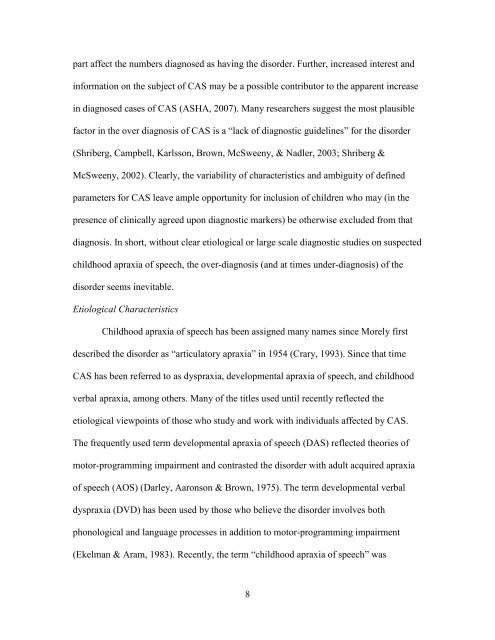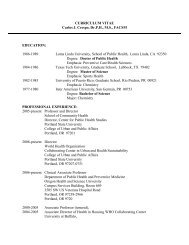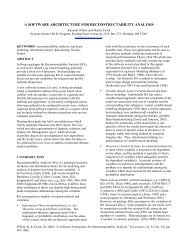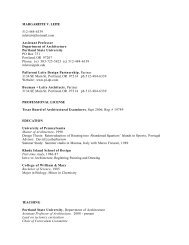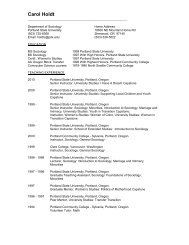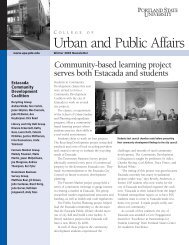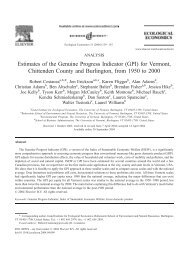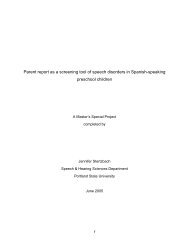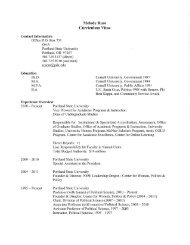Effects of integral stimulation therapy on speech - Portland State ...
Effects of integral stimulation therapy on speech - Portland State ...
Effects of integral stimulation therapy on speech - Portland State ...
Create successful ePaper yourself
Turn your PDF publications into a flip-book with our unique Google optimized e-Paper software.
part affect the numbers diagnosed as having the disorder. Further, increased interest and<br />
informati<strong>on</strong> <strong>on</strong> the subject <str<strong>on</strong>g>of</str<strong>on</strong>g> CAS may be a possible c<strong>on</strong>tributor to the apparent increase<br />
in diagnosed cases <str<strong>on</strong>g>of</str<strong>on</strong>g> CAS (ASHA, 2007). Many researchers suggest the most plausible<br />
factor in the over diagnosis <str<strong>on</strong>g>of</str<strong>on</strong>g> CAS is a “lack <str<strong>on</strong>g>of</str<strong>on</strong>g> diagnostic guidelines” for the disorder<br />
(Shriberg, Campbell, Karlss<strong>on</strong>, Brown, McSweeny, & Nadler, 2003; Shriberg &<br />
McSweeny, 2002). Clearly, the variability <str<strong>on</strong>g>of</str<strong>on</strong>g> characteristics and ambiguity <str<strong>on</strong>g>of</str<strong>on</strong>g> defined<br />
parameters for CAS leave ample opportunity for inclusi<strong>on</strong> <str<strong>on</strong>g>of</str<strong>on</strong>g> children who may (in the<br />
presence <str<strong>on</strong>g>of</str<strong>on</strong>g> clinically agreed up<strong>on</strong> diagnostic markers) be otherwise excluded from that<br />
diagnosis. In short, without clear etiological or large scale diagnostic studies <strong>on</strong> suspected<br />
childhood apraxia <str<strong>on</strong>g>of</str<strong>on</strong>g> <strong>speech</strong>, the over-diagnosis (and at times under-diagnosis) <str<strong>on</strong>g>of</str<strong>on</strong>g> the<br />
disorder seems inevitable.<br />
Etiological Characteristics<br />
Childhood apraxia <str<strong>on</strong>g>of</str<strong>on</strong>g> <strong>speech</strong> has been assigned many names since Morely first<br />
described the disorder as “articulatory apraxia” in 1954 (Crary, 1993). Since that time<br />
CAS has been referred to as dyspraxia, developmental apraxia <str<strong>on</strong>g>of</str<strong>on</strong>g> <strong>speech</strong>, and childhood<br />
verbal apraxia, am<strong>on</strong>g others. Many <str<strong>on</strong>g>of</str<strong>on</strong>g> the titles used until recently reflected the<br />
etiological viewpoints <str<strong>on</strong>g>of</str<strong>on</strong>g> those who study and work with individuals affected by CAS.<br />
The frequently used term developmental apraxia <str<strong>on</strong>g>of</str<strong>on</strong>g> <strong>speech</strong> (DAS) reflected theories <str<strong>on</strong>g>of</str<strong>on</strong>g><br />
motor-programming impairment and c<strong>on</strong>trasted the disorder with adult acquired apraxia<br />
<str<strong>on</strong>g>of</str<strong>on</strong>g> <strong>speech</strong> (AOS) (Darley, Aar<strong>on</strong>s<strong>on</strong> & Brown, 1975). The term developmental verbal<br />
dyspraxia (DVD) has been used by those who believe the disorder involves both<br />
ph<strong>on</strong>ological and language processes in additi<strong>on</strong> to motor-programming impairment<br />
(Ekelman & Aram, 1983). Recently, the term “childhood apraxia <str<strong>on</strong>g>of</str<strong>on</strong>g> <strong>speech</strong>” was<br />
8


